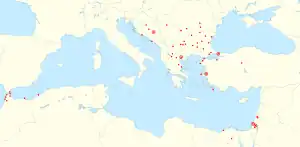犹太西班牙语
犹太西班牙语(西班牙語:;希伯來語:),又稱作拉迪諾語(Ladino)、Judezmo、Espanyol、Spaniolit等,是一個源自於中世紀西班牙語的羅曼語言,使用者主要是塞法迪犹太人。身為猶太後裔使用的語言,犹太西班牙语融合了希伯來語和亞拉姆語,尚受到阿拉伯語、土耳其語和少部分希臘語等語言的影響,因為塞法迪猶太人在奧圖曼帝國時期流亡時經過這些地方。
| 犹太西班牙语 | |
|---|---|
| |
 | |
| 母语国家和地区 | 以色列、土耳其、巴西、法國、希臘、馬其頓、波士尼亞赫塞哥維納、保加利亞、墨西哥、庫拉索 |
母语使用人数 | 總數在70,000至200,000人之間,近年來估計95,000人 (2013) |
| 語系 | |
| 文字 | 主要為拉丁字母 原本為Rashi和Solitreo 其他尚有阿拉伯字母, 西里爾字母, 希臘字母和希伯來字母。 |
| 官方地位 | |
| 承认少数语言 | |
| 管理机构 | |
| 語言代碼 | |
| ISO 639-2 | lad Ladino |
| ISO 639-3 | lad Ladino |
| 语言学家列表 | lad Ladino[1] |
| Glottolog | ladi1251 Ladino[2] |
| ELP | Ladino |
| 语言瞭望站 | 51-AAB-ba … 51-AAB-bd |
| IETF | lad |
 | |
| 瀕危程度 | |
| 联合国教科文组织认定的瀕危語言[3] 脆弱(UNESCO) | |
就像舊西班牙語,犹太西班牙语保留著上顎音[ʃ]和[ʒ],這兩個音在現代西班牙語中都已轉變成[x]。但與舊西班牙語不同的是,犹太西班牙语接受了一個希伯來語的/x/音。在某些地方,也發展出獨特的犹太西班牙语用法,比如以 muestro 替代 nuestro (our)。
就如同其他猶太語言,犹太西班牙语是瀕危語言,能夠流利使用的母語者大多為老年人,許多人在20世紀移民回以色列定居,他們並沒有教導他們的後代使用犹太西班牙语。然而近年來在賽法迪社群間興起小型的語言復興運動,特別是在音樂方面。而在拉丁美洲等地的孤立猶太人社群中,犹太西班牙语近來有逐漸融入當地西班牙語而被同化的危險。
語言名字
该语言的另称“拉迪諾”是“拉丁”的轉化。這種語言也被稱作Judæo-Spanish、Sefardi、Dzhudezmo、Judezmo以及Spanyol;Haquitía(源自阿拉伯語 haka حكى, "tell") 與北非方言有關,尤其是摩洛哥。這種方言在阿爾及利亞的Oran地區被稱為Tetuani,是因摩洛哥城市得土安而得名,因為很多Oranais猶太人來自這城市。在希伯來語中,這種語言被稱為Spanyolit。
現代教育
和意第緒語一樣,犹太西班牙语近來在美國和以色列大學教育中漸有復甦,然而由於猶太族裔的族群比例因素,各大學傾向開設意第緒語課程而非犹太西班牙语。目前美國有開設犹太西班牙语言課程的大學有賓夕法尼亞大學和塔夫茨大學,至於在以色列則是耶路撒冷希伯來大學提供犹太西班牙语課程。
註釋
- . MultiTree. [2017-07-08]. (原始内容存档于2021-01-25).
- Hammarström, Harald; Forkel, Robert; Haspelmath, Martin; Bank, Sebastian (编). . . Jena: Max Planck Institute for the Science of Human History. 2016.
- UNESCO Atlas of the World's Languages in danger, UNESCO
參考文獻
- Ashtor, Eliyahu, The Jews of Moslem Spain, Vol. 2, Philadelphia: Jewish Publication Society of America (1979)
- Assis, Yom Tov, The Jews of Spain: From Settlement to Expulsion, Jerusalem: Hebrew University of Jerusalem|The Hebrew University of Jerusalem (1988)
- Baer, Yitzhak. A History of the Jews of Christian Spain. 2 vols. Jewish Publication Society of America (1966).
- Bowers, W. P. "Jewish Communities in Spain in the Time of Paul the Apostle" in Journal of Theological Studies Vol. 26 Part 2, October 1975, pp. 395–402
- Dan, Joseph, "The Epic of a Millennium: Judeo-Spanish Culture's Confrontation" in Judaism Vol. 41, No. 2, Spring 1992
- Gampel, Benjamin R., "Jews, Christians, and Muslims in Medieval Iberia: Convivencia through the Eyes of Sephardic Jews," in Convivencia: Jews, Muslims, and Christians in Medieval Spain, ed. Vivian B. Mann, Thomas F. Glick, and Jerrilynn D. Dodds, New York: George Braziller, Inc. (1992)
- Kaplan, Yosef, An Alternative Path to Modernity: The Sephardi Diaspora in Western Europe. Brill Publishers (2000). ISBN 90-04-11742-3
- Katz, Solomon, Monographs of the Mediaeval Academy of America No. 12: The Jews in the Visigothic and Frankish Kingdoms of Spain and Gaul, Cambridge, Massachusetts: The Mediaeval Society of America (1937)
- Kedourie, Elie, editor. Spain and the Jews: The Sephardi Experience 1492 and After. Thames & Hudson (1992).
- Raphael, Chaim, The Sephardi Story: A Celebration of Jewish History London: Valentine Mitchell & Co. Ltd. (1991)
- Sarna, Nahum M., "Hebrew and Bible Studies in Medieval Spain" in Sephardi Heritage, Vol. 1 ed. R. D. Barnett, New York: Ktav Publishing House, Inc. (1971)
- Sassoon, Solomon David, "The Spiritual Heritage of the Sephardim," in The Sephardi Heritage, Vol. 1 ed. R. D. Barnett, New York: Ktav Publishing House Inc. (1971)
- Stein, Gloria Sananes, Marguerite: Journey of a Sephardic Woman, Morgantown, PA : Masthof Press, 1997.
- Stillman, Norman, "Aspects of Jewish Life in Islamic Spain" in Aspects of Jewish Culture in the Middle Ages ed. Paul E. Szarmach, Albany: State University of New York Press (1979)
- Swetschinski, Daniel. Reluctant Cosmopolitans: The Portuguese Jews of Seventeenth-Century Amsterdam. Litmann Library of Jewish Civilization, (2000)
- Zolitor, Jeff, "The Jews of Sepharad" Philadelphia: Congress of Secular Jewish Organizations (CSJO) (1997) ("The Jews of Sepharad" reprinted with permission on CSJO website.)
外部連結
Genealogy:
- Sefardies.org Sephardic Genealogy and official web in Spain
- Sephardic Genealogy (页面存档备份,存于)
- Multiple searchable databases for Sephardic genealogy (页面存档备份,存于)
- Consolidated Index of Sephardic Surnames (页面存档备份,存于)
- Extensive bibliography for Sephardim and Sephardic Genealogy (页面存档备份,存于)
- Sephardic names translated into English